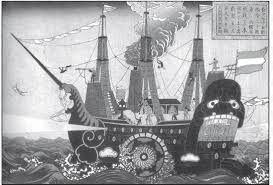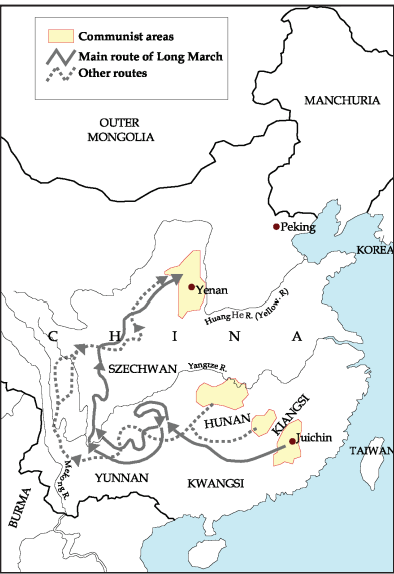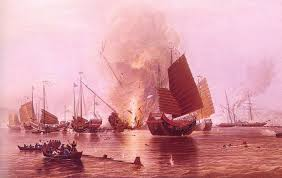Paths to Modernization – Complete Guide For Class 11 History Chapter 7
Welcome to iPrep, your Learning Super App. Our learning resources for the chapter, “Paths to Modernization” in History for Class 11th are designed to ensure that you grasp this concept with clarity and perfection. Whether you’re studying for an upcoming exam or strengthening your concepts, our engaging animated videos, practice questions and notes offer you the best of integrated learning with interesting explanations and examples.
Objectives Of Learning Paths to Modernization: A Comparative Study of East Asian Nations
This chapter explores the diverse paths taken by East Asian nations in their quest for modernization during the 19th and 20th centuries. It examines the impact of Western influence, traditional responses, and internal factors on the modernization processes of Japan, China, Korea, and Taiwan.
The 19th and 20th centuries witnessed a transformative period for East Asian nations, as they grappled with the challenges and opportunities presented by Western modernity. This chapter delves into the diverse paths taken by Japan, China, Korea, and Taiwan in their quest for modernization, examining the factors that shaped their development and the enduring legacies of their experiences.
Now that we have explored the importance of the chapter, let’s outline the objectives of studying it.
- To understand the historical context of East Asian modernization.
- To explore the impact of Western influence on East Asian societies.
- To examine the responses of traditional elites and social movements to Western modernity.
- To analyze the modernization processes of Japan, China, Korea, and Taiwan.
- To compare and contrast the different paths taken by these nations.
Now let’s explore the various sections of the chapter.
Firstly, in order to understand the early efforts toward modernization, let’s delve into the “Introductory” section of the chapter “Paths to Modernization.”
Introduction:
- The encounter with Western powers in the 19th century posed significant challenges and opportunities for East Asian nations.
- These challenges included military defeat, economic exploitation, and cultural imperialism, while opportunities included access to new technologies, knowledge, and ways of organizing society.

Now, to gain insight into Japan’s journey towards modernization, let’s explore the “Japan: The Meiji Restoration” section of the chapter “Paths to Modernization.”
Japan: The Meiji Restoration
Introduction
The Meiji Restoration in Japan marked a turning point in the country’s modernization process.
Now, lets explore the key points covered under this topic.
The Political System
- The Meiji government established a centralized and bureaucratic political system, abolishing feudal domains and implementing a new legal system based on Western models.
The Meiji Reforms
- The Meiji government implemented a series of reforms to modernize Japan’s economy, society, and military.
- These included the abolition of the feudal system, the establishment of a public education system, and the creation of a modern army and navy.

Modernizing the Economy
- Japan’s economic modernization was driven by industrialization and technological innovation.
- The Meiji government promoted the development of heavy industries such as steel, shipbuilding, and textiles, while also investing in education and scientific research to foster technological advancement.
Industrial Workers
- The rise of industrialization led to the emergence of a new class of industrial workers.
- The growth of the industrial working class contributed to the development of labor unions and social movements, as workers sought better wages, working conditions, and rights.

Aggressive Nationalism
- Japan’s modernization was accompanied by an aggressive foreign policy and expansionist ambitions.
- This aggressive foreign policy ultimately led to conflict with neighboring powers and culminated in Japan’s involvement in World War II.
‘Westernisation’ and ‘Tradition’
- The debate over the extent of Westernization and the preservation of traditional values continued in Japan.
- This led to a complex and often conflicting debate about the appropriate balance between modernity and tradition.
Daily Life
- Modernization brought significant changes to daily life in Japan.
- The introduction of Western technologies, such as railways, telegraphs, and factories, transformed the way people lived and worked.

‘Overcoming Modernity’
- While many embraced the benefits of modernization, such as economic growth and technological advancement, others were concerned about the potential loss of traditional values and cultural identity.
- Some Japanese intellectuals and cultural figures advocated for a more selective approach to Westernization, emphasizing the importance of preserving Japanese traditions while adopting those aspects of Western culture that were deemed beneficial.
After Defeat: Re-emerging as a Global Economic Power
- Despite its defeat in World War II, Japan experienced a remarkable economic recovery and became a global economic power.
- With the support of the United States, Japan was able to rebuild its economy and achieve rapid economic growth.
Now, to better understand China’s quest for modernity, let’s explore the “China: The Search for Modernity” section of the chapter “Paths to Modernization.”
China: The Search for Modernity
China’s path to modernization was marked by internal struggles and external pressures.
Let’s explore the key points covered under this topic.
The Opium Trade
- The East India Company engaged in triangular trade between Britain, India, and China.
- They sold opium in China, using the silver earned to buy Chinese goods for sale in Britain.
- This created a serious balance-of-trade problem as Western goods were not popular in China.

The Search for Modernity:
- Chinese intellectuals and reformers sought to modernize China while preserving its cultural heritage.
- This led to a complex and often conflicting debate about the appropriate balance between tradition and modernity.
Establishing the Republic
- The establishment of the Republic of China in 1911 marked a significant turning point in Chinese history.
- The establishment of the republic was a culmination of years of anti-imperialist and revolutionary movements, inspired by Western ideas of democracy and nationalism.
- However, the Republic of China faced numerous challenges, including political instability, economic difficulties, and the threat of foreign intervention.
The Rise of the Chinese Communist Party:
- The Chinese Communist Party emerged as a powerful force in Chinese politics.
- Founded in 1921, the CCP gained strength through its grassroots organization, revolutionary ideology, and ability to mobilize the peasantry.
- The CCP’s influence grew during the Chinese Civil War, and it ultimately defeated the Nationalist Party in 1949, establishing the People’s Republic of China.

Establishing the New Democracy: 1949-65
- The Communist Party’s victory in the Chinese Civil War led to the establishment of the People’s Republic of China.
- The establishment of the PRC had profound implications for China’s domestic and foreign affairs, as well as for the global balance of power.
Conflicting Visions: 1965-78
- Mao Zedong’s policies, such as the Great Leap Forward and the Cultural Revolution, had mixed results.
- The Great Leap Forward, launched in 1958, resulted in widespread famine and economic hardship.
- The Cultural Revolution, which began in 1966, led to political turmoil, violence, and the destruction of cultural heritage.
- Despite their negative consequences, these policies also had some positive effects, such as mobilizing the population and fostering a sense of national unity.
Reforms from 1978
- Deng Xiaoping’s economic reforms ushered in a new era of modernization for China.
- These reforms led to rapid economic growth and transformed China into a global economic powerhouse.

Now, to understand Taiwan’s journey toward modernization, let’s explore “The Story of Taiwan” section of the chapter “Paths to Modernization.”
The Story of Taiwan
- Taiwan’s modernization was influenced by its unique historical and geopolitical circumstances.
- As an island off the coast of mainland China, Taiwan has faced a complex relationship with its larger neighbor.
- After the Chinese Civil War in 1949, the Nationalist government retreated to Taiwan, establishing the Republic of China.
- Since then, Taiwan has developed as a separate political entity, facing challenges related to its sovereignty and security.
- Despite these challenges, Taiwan has achieved significant economic and social development, becoming a model of modernization in East Asia.
Now, to gain a better understanding of Korea’s modernization, let’s explore “The Story of Korea” section of the chapter “Paths to Modernization.”
The Story of Korea
Korea’s modernization was shaped by its division into North and South Korea.
Beginnings of Modernisation
- Both North and South Korea embarked on modernization efforts after the Korean War.
- However, the two countries followed very different paths, reflecting their contrasting political ideologies and geopolitical circumstances. North Korea pursued a centrally planned socialist economy and a totalitarian political system, while South Korea adopted a market-oriented economy and a democratic political system.
- These divergent paths led to significantly different outcomes in terms of economic development, social welfare, and human rights.

A Post-War Nation
- South Korea faced significant challenges after the Korean War, including economic devastation and the threat of North Korean aggression.
- Despite these obstacles, the country implemented successful economic reforms that led to rapid development and prosperity.
Rapid Industrialisation under Strong Leadership
- South Korea’s economic development was driven by strong leadership, government intervention, and a focus on export-oriented industries.
- The South Korean government played a central role in guiding the country’s economic development, implementing policies that promoted industrialization, investment, and exports.
- This approach led to rapid economic growth and transformed South Korea into a global economic powerhouse.
Continued Economic Growth and Calls for Democratisation
- South Korea’s economic success was accompanied by growing calls for political liberalization and democracy.
- The authoritarian government faced increasing pressure to democratize, and in the late 1980s and early 1990s, South Korea underwent a peaceful transition to democracy.
- This marked a significant milestone in the country’s political development and solidified its reputation as a model of economic and political modernization in East Asia.
Korean Democracy and the IMF Crisis
- The Asian financial crisis of 1997 posed a major challenge to South Korea’s economic and political development.
- The crisis also served as a catalyst for further political and economic reforms, as South Korea sought to strengthen its resilience and competitiveness in the global economy.
Two Roads to Modernisation
- The experiences of Japan, China, Korea, and Taiwan demonstrate the diversity of paths taken by East Asian nations in their quest for modernization.
- Each country faced unique historical, cultural, and geopolitical circumstances that shaped its modernization process.
- These diverse experiences highlight the complexity and challenges of modernization in East Asia and offer valuable lessons for other developing nations.

Finally, as we have gained comprehensive knowledge about the chapter “Paths to Modernization”, let’s reflect on the overall learning value of this important lesson.
Overall Learning Experiences
The modernization of East Asian nations was a complex and multifaceted process, shaped by a variety of factors, including Western influence, traditional responses, internal struggles, and external pressures. While each nation followed its own unique path, they all shared a common goal of building modern, prosperous, and powerful societies. The experiences of these nations offer valuable insights into the challenges and opportunities of modernization in the contemporary world.
Let’s Conclude
In conclusion, the journey through CBSE Class 11th History Chapter “Paths to Modernization” offers a rich understanding of how Japan, China, Korea, and Taiwan each navigated unique paths to modernity. As you have seen, each nation’s experience was shaped by a blend of Western influences, cultural traditions, and internal dynamics. The chapter “Paths to Modernization” for Class 11th History enables students to grasp these intricate histories and compare how each country’s strategy led to different outcomes in modernization.
Studying “Paths to Modernization” for Class 11th not only broadens historical knowledge but also provides critical insights into the broader socio-political transformations in East Asia. Through iPrep’s resources, from animated videos to comprehensive notes, students can engage deeply with the themes of this chapter, making CBSE Class 11th History Chapter “Paths to Modernization” both engaging and educational.
Practice questions on Chapter 7 - Paths to Modernization
Get your free Chapter 7 - Paths to Modernization practice quiz of 20+ questions & detailed solutions
Practice Now








